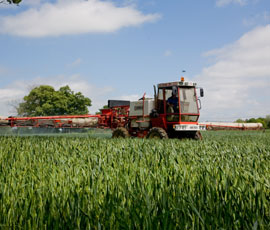Confidence in choosing fungicides

With flag leaf emergence just a few weeks away, it’s decision time about what and how much fungicide to use in your wheat.
Offering a helping hand is the HGCA dose-response work on the main fungicides on the market, even the newest two. The freshly updated figures could be even more valuable than usual with wheat prices predicted to be around £150/t at harvest, says Jonathan Blake of ADAS.
“With returns looking good, it’s worth using the best input or mixture you can get your hands on. Performance data can help you compare, like for like, new products with existing chemistry. At the touch of a button, you can see how the two active ingredients new for winter wheat this season – bixafen and isopyrazam – rate alongside what you use now.”
He acknowledges that treatments in fungicide performance trials are applied as single treatments against each disease so are not strictly representative of field use. And some assessments had to be made on the active ingredient as a component of a formulated mixture.
Nevertheless, understanding efficacy for each of the components of mixtures and sequences indicates the likely performance growers can expect of spray programmes. Mr Blake sees the curves as invaluable in deciding what and how much of any one active to apply in fungicide mixtures, to ensure cost-effective control of disease.
The newcomers come out on top when used in mixtures compared with two sprays of the straight triazole, all at half the full recommended rates, says Mr Blake. As with strobilurins, there is a yield advantage that can’t be attributed to disease control alone, courtesy of extended green leaf area duration.
Bixafen, formulated with prothioconazole as Aviator, was shown to be significantly more effective than straight Proline (prothioconazole). It offers protectant and curative activity against septoria, and has efficacy against rusts and mildew. Used at T2, in most cases 1 litre/ha should effectively control disease, though there may be benefits in using the full 1.25 litres/ha rate where Septoria tritici pressure is very high, he explains.
Isopyrazam has been tested both alone and as Seguris with epoxiconazole, so we have a clearer picture of its activity. The HGCA data indicates this SDHI has excellent activity on rusts and very good protectant activity against septoria. A rate of 0.75-1litre/ha should be appropriate at T2 in most situations, he adds.
“We see some products working better and persisting longer as the dose increases towards the full recommended rate, but in low-pressure situations and where yield potential is low, that rate isn’t necessarily cost-effective. Our curves estimate both new products offer yield advantages, though their price will ultimately determine cost-effectiveness.”
The same data has been collected for barley and oilseed rape fungicides over recent years. This ensures growers will have sufficient information to use novel materials to best effect, as soon as they are available.
All three projects have HGCA funding for another three years, by which time we’ll have a clear picture of how other new SDHIs may work in the field, hopes Mr Blake. That way, growers can safeguard disease control and maximise farm profitability in the long term.

